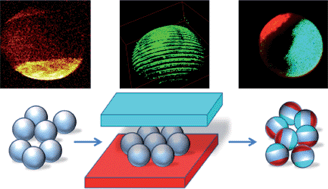Bifunctional Janus beads made by “sandwich” microcontact printing using click chemistry†
Abstract
This article describes the preparation of spherical Janus particles by

* Corresponding authors
a
Organisch-Chemisches Institut, Westfälische Wilhelms-Universität Münster, Corrensstraße 40, 48149 Münster, Germany
E-mail:
b.j.ravoo@uni-muenster.de
Fax: +49 251 83 36557
Tel: +49 251 83 33287
b
Department of Organic Chemistry, Ghent University, Krijgslaan 281 S4, 9000 Gent, Belgium
E-mail:
Filip.DuPrez@UGent.be
Fax: +329 2644972
Tel: +329 2644503
c Physikalisches Institut, Westfälische Wilhelms-Universität Münster, Wilhelm-Klemm-Straße 10, 48149 Münster, Germany
This article describes the preparation of spherical Janus particles by

 Please wait while we load your content...
Something went wrong. Try again?
Please wait while we load your content...
Something went wrong. Try again?
T. Kaufmann, M. T. Gokmen, S. Rinnen, H. F. Arlinghaus, F. Du Prez and B. J. Ravoo, J. Mater. Chem., 2012, 22, 6190 DOI: 10.1039/C2JM16807C
To request permission to reproduce material from this article, please go to the Copyright Clearance Center request page.
If you are an author contributing to an RSC publication, you do not need to request permission provided correct acknowledgement is given.
If you are the author of this article, you do not need to request permission to reproduce figures and diagrams provided correct acknowledgement is given. If you want to reproduce the whole article in a third-party publication (excluding your thesis/dissertation for which permission is not required) please go to the Copyright Clearance Center request page.
Read more about how to correctly acknowledge RSC content.
 Fetching data from CrossRef.
Fetching data from CrossRef.
This may take some time to load.
Loading related content
